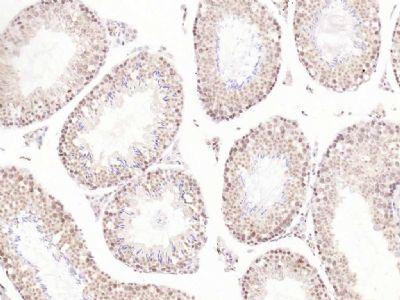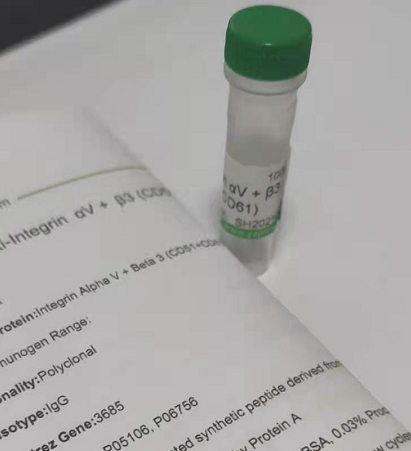| 產(chǎn)品編號(hào) | Ys-0255R |
| 英文名稱(chēng) | Estrogen receptor beta |
| 中文名稱(chēng) | 雌激素受體β抗體 |
| 別 名 | Estrogen receptor-beta; Estrogen receptor beta; ER BETA; ER-BETA; ER-beta; Erb; ESR 2; ESR 2; ESR B; ESR-B; ESR BETA; ESR-BETA; ESR2; ESR2; ESR2_HUMAN; ESRB; ESTRB; estrogen nuclear receptor beta variant a; estrogen nuclear receptor beta variant b; estrogen receptor 2 (ER beta); Estrogen Receptor 2; Estrogen Receptor-2; estrogen receptor beta 4; NR3A2; Nuclear receptor subfamily 3 group A member 2. |
| 抗體來(lái)源 | Rabbit |
| 克隆類(lèi)型 | Polyclonal |
| 交叉反應(yīng) | Human, Mouse, |
| 產(chǎn)品應(yīng)用 | WB=1:500-2000 ELISA=1:5000-10000 IHC-P=1:100-500 IHC-F=1:100-500 IF=1:100-500 (石蠟切片需做抗原修復(fù)) not yet tested in other applications. optimal dilutions/concentrations should be determined by the end user. |
| 理論分子量 | 58kDa |
| 細(xì)胞定位 | 細(xì)胞核 |
| 性 狀 | Liquid |
| 濃 度 | 1mg/ml |
| 免 疫 原 | KLH conjugated synthetic peptide derived from human ER-Beta: 50-100/530 |
| 亞 型 | IgG |
| 純化方法 | affinity purified by Protein A |
| 緩 沖 液 | 0.01M TBS(pH7.4) with 1% BSA, 0.03% Proclin300 and 50% Glycerol. |
| 保存條件 | Shipped at 4℃. Store at -20 °C for one year. Avoid repeated freeze/thaw cycles. |
| 注意事項(xiàng) | This product as supplied is intended for research use only, not for use in human, therapeutic or diagnostic applications. |
| PubMed | PubMed |
| 產(chǎn)品介紹 | This gene encodes a member of the family of estrogenreceptors and superfamily of nuclear receptor transcriptionfactors. The gene product contains an N-terminal DNA binding domainand C-terminal ligand binding domain and is localized to thenucleus, cytoplasm, and mitochondria. Upon binding to17beta-estradiol or related ligands, the encoded protein formshomo- or hetero-dimers that interact with specific DNA sequences toactivate transcription. Some isoforms dominantly inhibit theactivity of other estrogen receptor family members. Severalalternatively spliced transcript variants of this gene have beendescribed, but the full-length nature of some of these variants hasnot been fully characterized. [provided by RefSeq, Jul 2008]. Function: Nuclear hormone receptor. Binds estrogens with an affinity similar to that of ESR1, and activates expression of reporter genes containing estrogen response elements (ERE) in an estrogen-dependent manner. Isoform beta-cx lacks ligand binding ability and has no or only very low ere binding activity resulting in the loss of ligand-dependent transactivation ability. DNA-binding by ESR1 and ESR2 is rapidly lost at 37 degrees Celsius in the absence of ligand while in the presence of 17 beta-estradiol and 4-hydroxy-tamoxifen loss in DNA-binding at elevated temperature is more gradual. Subunit: Binds DNA as a homodimer. Can form a heterodimer with ESR1. Interacts with NCOA3, NCOA5 and NCOA6 coactivators, leading to a strong increase of transcription of target genes. Interacts with PELP1 and UBE1C. Isoform beta-2/cx preferentially forms a heterodimer with ESR1 rather than ESR2 and inhibits DNA-binding by ESR1. Interacts with AKAP13. Interacts with DNTTIP2. Interacts with isoform 4 of TXNRD1. Interacts with CCDC62 in the presence of estradiol/E2; this interaction seems to enhance the transcription of target genes, including cyclin-D1/CCND1 AP-1 promoter. Interacts with DYX1C1. Interacts with PRMT2. Subcellular Location: Nucleus. Tissue Specificity: Tissue specificityIsoform beta-1 is expressed in testis and ovary, and at a lower level in heart, brain, placenta, liver, skeletal muscle, spleen, thymus, prostate, colon, bone marrow, mammary gland and uterus. Also found in uterine bone, breast, and ovarian tumor cell lines, but not in colon and liver tumors. Isoform beta-2 is expressed in spleen, thymus, testis and ovary and at a lower level in skeletal muscle, prostate, colon, small intestine, leukocytes, bone marrow, mammary gland and uterus. Isoform beta-3 is found in testis. Isoform beta-4 is expressed in testis, and at a lower level in spleen, thymus, ovary, mammary gland and uterus. Isoform beta-5 is expressed in testis, placenta, skeletal muscle, spleen and leukocytes, and at a lower level in heart, lung, liver, kidney, pancreas, thymus, prostate, colon, small intestine, bone marrow, mammary gland and uterus. Not expressed in brain. Similarity: Belongs to the nuclear hormone receptor family. NR3 subfamily. Contains 1 nuclear receptor DNA-binding domain. SWISS: Q92731 Gene ID: 2100 |
| 產(chǎn)品圖片 |  Paraformaldehyde-fixed, paraffin embedded (mouse testis); Antigen retrieval by boiling in sodium citrate buffer (pH6.0) for 15min; Block endogenous peroxidase by 3% hydrogen peroxide for 20 minutes; Blocking buffer (normal goat serum) at 37°C for 30min; Antibody incubation with (Estrogen receptor beta) Polyclonal Antibody, Unconjugated (bs-0255R) at 1:200 overnight at 4°C, followed by operating according to SP Kit(Rabbit) (sp-0023) instructionsand DAB staining. |
我要詢(xún)價(jià)
*聯(lián)系方式:
(可以是QQ、MSN、電子郵箱、電話(huà)等,您的聯(lián)系方式不會(huì)被公開(kāi))
*內(nèi)容:









